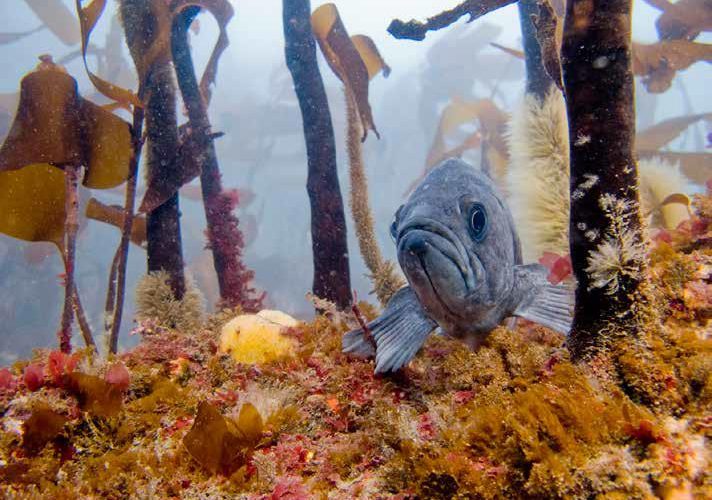STORY BY Kelsey Adkisson
PHOTOS COURTESY Scott Groth
A look at five fascinating species of fish that inhabit Oregon’s marine reserves.
Deep beneath Oregon’s bone-chilling Pacific waters is a fish that grabs unlucky victims using razor-sharp teeth in its football-sized gaping mouth. Other fish, some of which live almost twice as long as the average human, gleam with fiery shades of yellows, oranges and reds.
Welcome to Oregon’s marine reserves, underwater living laboratories found right off our coast. Beneath the surface of the waves, craggy pinnacles give way to expansive sandy flats. Golden brown kelp sways with the pulsing currents.
In 2012, Oregon launched a system of five reserves—closed to fishing and offshore development—that dot the nearshore waters off our coast. The reserves act as scientific controls in a giant, wild experiment. They are places where scientists can study potential ecological changes over time, in the absence of extra stresses. The Oregon Department of Fish and Wildlife is tasked with managing the reserves and conducting research to see how changes in the reserves compare to larger ocean changes occurring over time.
Ironically, for a state famous for exploration, we’ve only just skimmed the surface of our coastal waters. This highly productive strip of the ocean bumps up to the shoreline, and extends about three miles out to sea. This is a high-energy environment, with crashing waves and strong underwater surge where the land meets the sea. It’s a nursery ground for baby fish and the outfall of deep, upwelled, nutrient-rich water. Plus, it’s where kelps and seaweeds grow, since it’s too deep and dark farther offshore.
The reserves are situated in the heart of this rich, dynamic coastal environment that is home to colorful invertebrates, countless types of algae and of course, many species of fish.
So, let’s dive in and meet a few fish species that call the marine reserves home. They are, of course, found outside the reserves as well, but in these areas, they are protected.
BLACK ROCKFISH
 These are regulars on your favorite local seafood dinner menu and are a backbone of the Oregon fishing industry. Local fishermen like to call these fish a “bread & butter” species because they provide consistent income. Black rockfish are the most regularly observed fish in the marine reserves. Like their name suggests, they are mottled shades of black and gray. Baby black rockfish settle in coastal waters, sometimes ending up in tidepools where they’ll stay for a month or more. Females tend to grow larger than males and can live to be over 50 years old.
These are regulars on your favorite local seafood dinner menu and are a backbone of the Oregon fishing industry. Local fishermen like to call these fish a “bread & butter” species because they provide consistent income. Black rockfish are the most regularly observed fish in the marine reserves. Like their name suggests, they are mottled shades of black and gray. Baby black rockfish settle in coastal waters, sometimes ending up in tidepools where they’ll stay for a month or more. Females tend to grow larger than males and can live to be over 50 years old.
LINGCOD
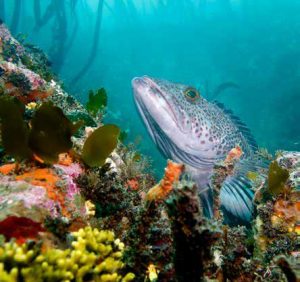 This species is known as the predator of the nearshore and “alligator of the ocean,” thanks to its huge tooth-filled mouth, ability to stalk prey, and tendency to barrel roll when caught.
This species is known as the predator of the nearshore and “alligator of the ocean,” thanks to its huge tooth-filled mouth, ability to stalk prey, and tendency to barrel roll when caught.
Lingcod reproduction is progressive: A female lays eggs, which will be fertilized by a male—or up to five males. The female then takes off to faraway places. Meanwhile, the dad stays behind to guard the eggs until they hatch. Sometimes there’s battling among multiple dads on which father gets to guard the eggs.
YELLOWEYE ROCKFISH
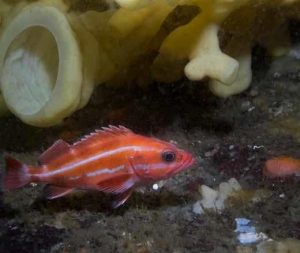 There are yelloweye rockfish alive today that were born a
There are yelloweye rockfish alive today that were born a
few years after the Civil War ended. This is one of the longest-lived species in the entire Pacific Ocean. Gleaming fiery orange and red with bright yellow eyes, this fish takes its time to mature. They only start to reproduce at around 20 years old and can live to be 150 years old.
CHINA ROCKFISH
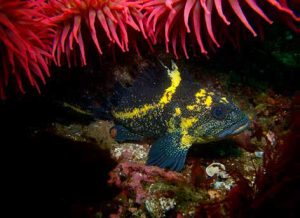 These fish are like a hometown hero. They are flashy and good looking. They also spend their entire lives—75 years or so—in one spot. China rockfish have an affinity for rocky reefs and crevices. They tend to be territorial and will puff up and poke up their spines when facing an intruder. Sometimes they boldly take over the den of a Pacific octopus.
These fish are like a hometown hero. They are flashy and good looking. They also spend their entire lives—75 years or so—in one spot. China rockfish have an affinity for rocky reefs and crevices. They tend to be territorial and will puff up and poke up their spines when facing an intruder. Sometimes they boldly take over the den of a Pacific octopus.
CABEZON
The name cabezon literally translates to “scorpion fish” and means “large head” in Spanish (they do have exceptionally large heads). Interesting fact: their large mouths and constant croaking have inspired their tongue-in-cheek nickname “mother-in-law fish.” 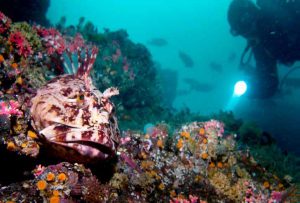 Unlike their rockfish counterparts, cabezon are a type of sculpin. They do not have scales and only live to be about 20 years old. Cabezon were a regular food source for Native Americans living in the Pacific Northwest. However, when Europeans made it to the West coast, they weren’t fond of them. Why? They said they were too ugly to eat.
Unlike their rockfish counterparts, cabezon are a type of sculpin. They do not have scales and only live to be about 20 years old. Cabezon were a regular food source for Native Americans living in the Pacific Northwest. However, when Europeans made it to the West coast, they weren’t fond of them. Why? They said they were too ugly to eat.
***
There’s still lots more to explore in Oregon’s marine reserves. These living laboratories are providing Oregonians and scientists alike a deeper understanding of the ocean in our backyard. The ultimate goal is to study how we can best maintain our rich coastal areas for generations to come. Be sure to dive in and explore more at OregonMarineReserves.com.
If you want to read another Oregon Coast magazine story on Oregon’s marine reserves, click on Undersea Riches.
This story appeared in the Spring 2020 issue of Oregon Coast magazine.

